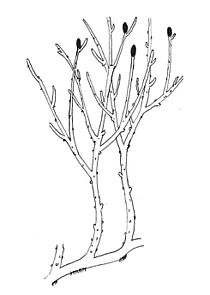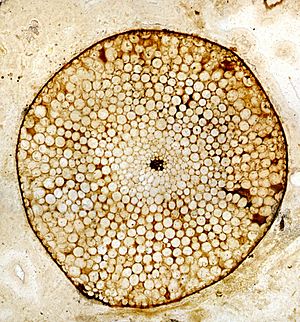Rhynia facts for kids
Quick facts for kids Rhynia |
|
|---|---|
 |
|
| Reconstruction of Rhynia gwynne-vaughanii, redrawn after Kenrick & Crane (1997:101) | |
| Scientific classification |
|
| Subdivisio: | †Rhyniophytina |
| Class: | †Rhyniopsida |
| Order: | †Rhyniales |
| Family: | †Rhyniaceae |
| Genus: | †Rhynia Kidst. & W.H.Lang (1917) |
| Species | |
|
|

Rhynia is a very old fossil plant. It lived during the Devonian Period, a long time ago. Scientists have only found one type of Rhynia, called R. gwynne-vaughanii. This plant was one of the first true vascular plants to grow on land.
Rhynia was more advanced than simpler land plants like mosses. It had special tubes inside to carry water and food. This helped it grow taller than plants without these tubes.
Contents
What Was the Devonian Period?
The Devonian Period was a time in Earth's history. It lasted from about 419 to 359 million years ago. During this period, many new types of fish appeared in the oceans. On land, plants like Rhynia started to grow and spread. This was a big step for life on Earth.
Before the Devonian, most life was in the water. Plants slowly began to move onto land. They had to adapt to new challenges. These included getting water, staying upright, and reproducing without being in water. Rhynia shows us how early plants solved some of these problems.
How Did Rhynia Look?
Rhynia was a simple plant. It did not have true leaves or roots like plants today. Instead, it had thin, branching stems. These stems grew upright from a creeping underground stem. This underground part was called a rhizome. Small root-like structures, called rhizoids, grew from the rhizome. They helped the plant attach to the ground.
The stems of Rhynia were smooth and green. They could grow up to 50 centimeters (about 20 inches) tall. At the tips of some stems, there were small, oval-shaped structures. These were called sporangia.
Reproduction of Rhynia
The sporangia were important for Rhynia's reproduction. Inside the sporangia, the plant made tiny spores. These spores were like seeds. When the sporangia opened, the spores were released. The wind would then carry them away. If a spore landed in a good spot, it could grow into a new Rhynia plant.
Rhynia represents the sporophyte generation of a vascular plant. This means it was the part of the plant that made spores. This way of reproducing was common for early land plants.
Why is Rhynia Important?
Rhynia is very important to scientists. Its fossils give us clues about how plants evolved. It shows us how plants moved from water to land. It also shows how they developed vascular systems. These systems were key for plants to grow larger and spread across the land.
The fossils of Rhynia are very well preserved. They were found in Scotland. Scientists can see the actual cells of the plant. This helps them understand its structure in great detail. Rhynia helps us learn about the early history of all land plants.
See also
In Spanish: Rhynia para niños

